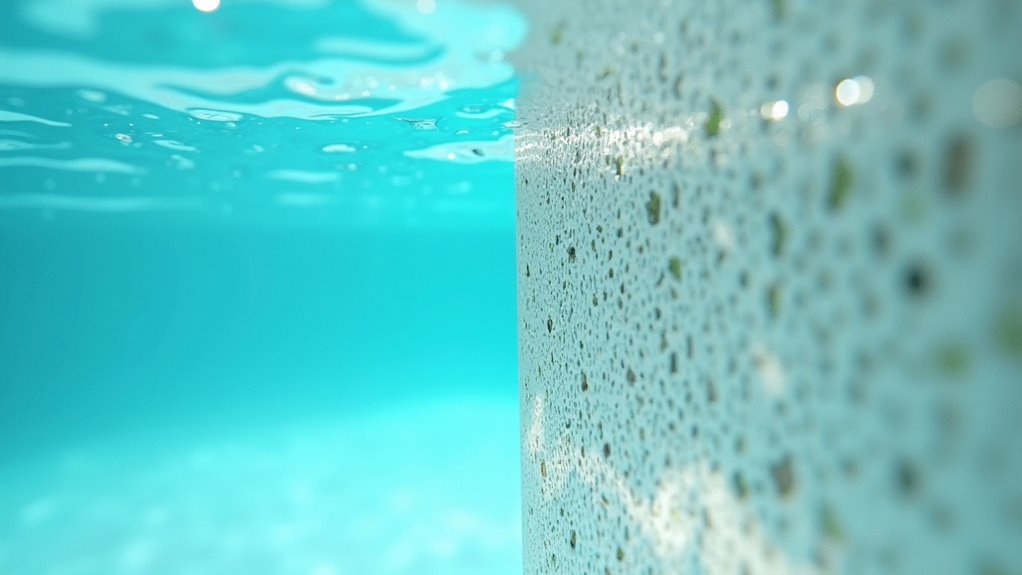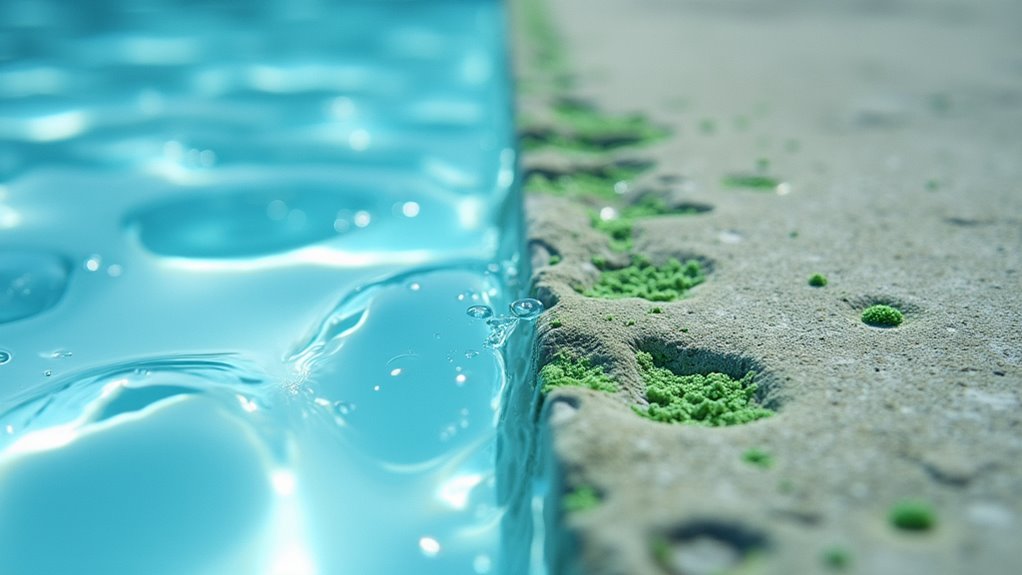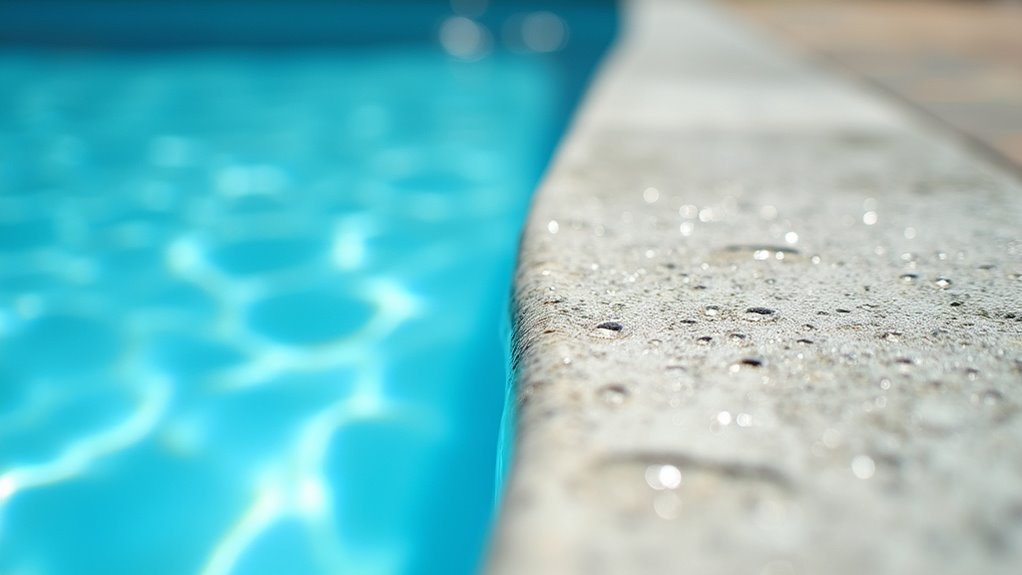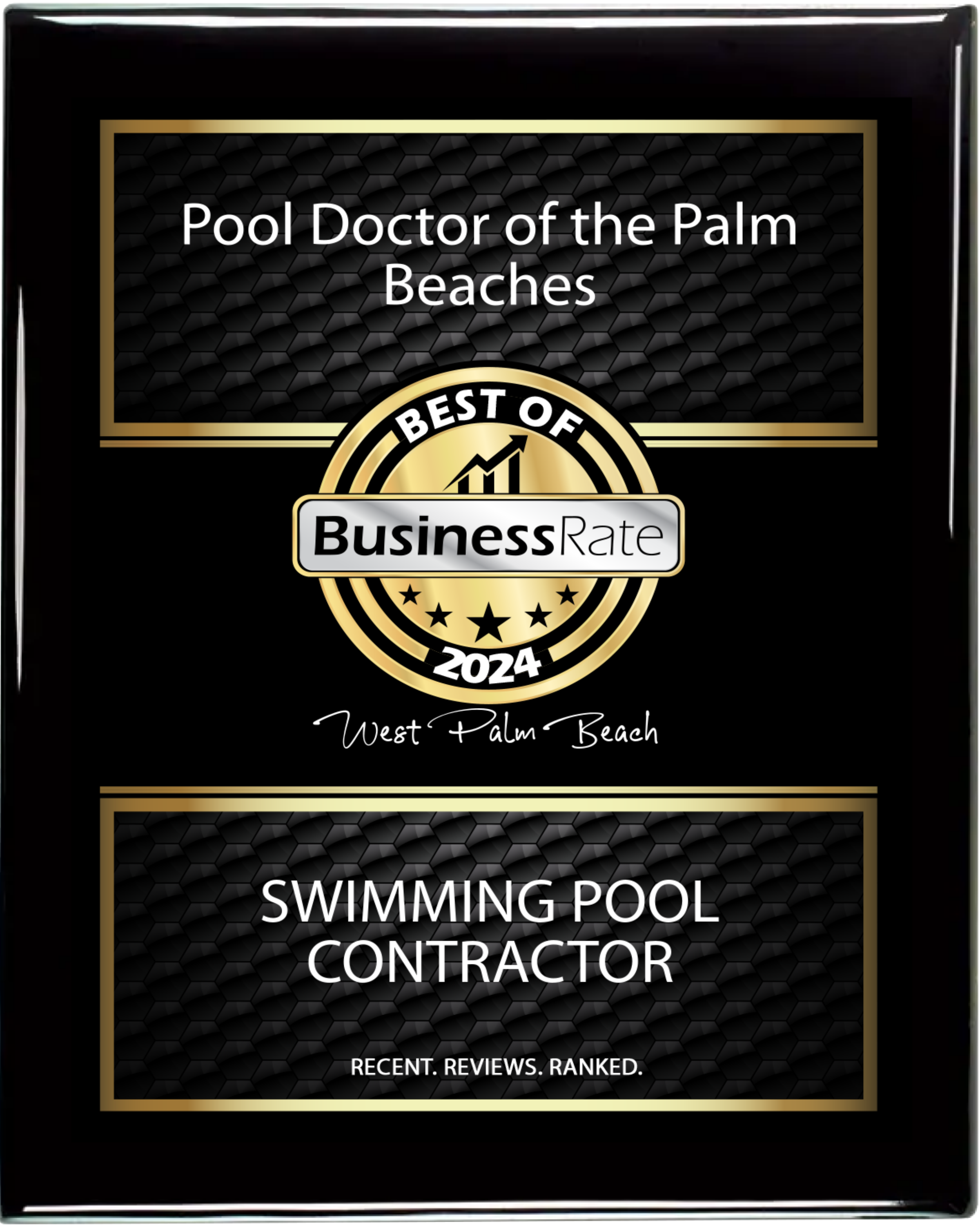Yes, your fiberglass pool will resist algae growth better than concrete or vinyl pools due to its non-porous gel-coat surface. The smooth, impermeable finish prevents algae spores from establishing attachment points, while concrete’s porous nature and vinyl’s seams provide ideal spots for algae to take hold. You’ll spend less time and money on maintenance with a fiberglass pool, though proper chemical balance and filtration are still essential. Understanding the science behind this advantage can help enhance your pool’s algae resistance.
Key Takeaways
- Fiberglass pools have non-porous, smooth gel-coat surfaces that make it harder for algae to attach and grow compared to other materials.
- Concrete pools are more susceptible to algae growth due to their porous surface, which provides numerous attachment points for algae.
- The smooth surface of fiberglass pools enables easier cleaning and requires less frequent maintenance than concrete or vinyl alternatives.
- Fiberglass pools need fewer chemicals for maintenance, reducing both the cost and effort required to prevent algae growth.
- Vinyl liner pools fall between fiberglass and concrete in algae resistance, but their seams and wrinkles can harbor algae growth.
Understanding How Algae Forms in Swimming Pools

While all swimming pools can develop algae, understanding the fundamental conditions that promote its growth is vital for prevention. Algae spores enter your pool through wind, rain, or contaminated equipment, initiating the algae life cycle when conditions are favorable. These microscopic organisms thrive when they find three key elements: sunlight, warm temperatures, and nutrients.
Your pool water chemistry plays an important role in either preventing or enabling algae growth. When pH levels drift above 7.8, chlorine becomes less effective at sanitization, creating an environment where algae can multiply rapidly. Furthermore, low sanitizer levels, poor circulation, and accumulated phosphates provide ideal conditions for algae blooms. You’ll typically notice the initial signs of growth in areas with poor water circulation or shadows, where algae can attach to surfaces and begin colonizing.
The Science Behind Pool Surface Materials

Three primary materials dominate modern pool construction: fiberglass, concrete, and vinyl liner. Each material’s molecular structure and surface properties directly affect how algae can attach and proliferate in your pool. Fiberglass pool design trends now feature advanced technologies and stylish upgrades that boost both looks and performance. Their smooth surfaces resist algae, making them easier to maintain than concrete or vinyl pools.
Fiberglass pools feature a non-porous, gel-coat surface that creates an exceptionally smooth finish. This material property makes it difficult for algae to establish strong attachment points. In contrast, concrete’s porous nature provides numerous microscopic cavities where algae can take hold and multiply, even with proper surface finishing. Vinyl liner pools fall between these two extremes, offering a synthetic surface that’s relatively smooth but can develop wrinkles and seams where algae may collect.
The material properties of your pool surface play an essential role in maintenance requirements and long-term algae prevention strategies.
Key Features of Fiberglass Pool Surfaces

Modern fiberglass pool surfaces incorporate a specialized gel coat that delivers multiple performance advantages. You’ll find that this non-porous coating creates an exceptionally smooth surface texture that makes it difficult for algae to establish a foothold. The gel coat’s microscopic structure prevents organic materials from embedding themselves into the surface, unlike concrete or vinyl alternatives.
The surface’s inherent smoothness also simplifies your cleaning techniques, as you won’t need aggressive brushing or harsh chemicals to maintain it. You’ll notice that the gel coat’s glossy finish doesn’t just look attractive it’s engineered to resist UV damage and maintain its protective properties for decades. When properly maintained, the surface’s molecular composition actively works to prevent the formation of biofilm, which typically serves as an anchor point for algae colonies.
Comparing Algae Growth Rates Across Pool Types
Because different pool surfaces create distinct microenvironments, you’ll observe significant variations in algae proliferation rates across pool types. Fiberglass pools typically show lower algae growth rates compared to concrete or vinyl pools, due to their non-porous, smooth gel coat surface that inhibits algae attachment.
You’ll find that concrete pools are most susceptible to algae growth, as their porous texture provides numerous colonization points. Vinyl pools fall between these extremes, though their seams can harbor stubborn algae colonies. For effective algae prevention, you’ll need to maintain proper chemical balance and filtration regardless of pool type. However, you’ll spend less time on pool maintenance with fiberglass, as its smooth surface makes brushing and chemical treatments more efficient, reducing the likelihood of persistent algae problems.
Chemical Balance and Maintenance Requirements
While the smooth surface of fiberglass pools helps minimize algae growth, maintaining proper chemical balance remains a key factor in pool care. You’ll need to monitor pH levels between 7.2 and 7.6, chlorine levels at 1-3 ppm, and alkalinity between 80-120 ppm to prevent algae formation.
The chemical composition of your pool water requires weekly testing and adjustment. Though fiberglass pools may need less frequent maintenance than concrete or vinyl pools, you shouldn’t skip regular chemical checks. You’ll still need to maintain proper sanitizer levels and balance other chemicals to prevent algae growth. Set a consistent maintenance frequency, testing water chemistry twice weekly during peak swimming season and adjusting as needed. This proactive approach helps prevent algae before it can establish a foothold in your fiberglass pool.
Cost Analysis: Long-Term Algae Prevention
Although the initial investment in algae prevention equipment may seem substantial, implementing a thorough maintenance strategy for your fiberglass pool proves more cost-effective than dealing with severe algae outbreaks.
A cost comparison reveals that you’ll spend approximately $30-50 monthly on routine chemical treatments and testing supplies for algae prevention, while a single algae outbreak can cost $200-400 to remediate. Maintenance expenses for automated chlorinators and UV systems typically range from $150-300 annually, but they considerably reduce the risk of algae formation. You’ll also save on labor costs since fiberglass pools require fewer chemicals and less frequent maintenance than concrete or vinyl pools. By investing in preventive measures, you’ll protect your pool’s surface and avoid costly emergency treatments that could damage your pool’s gelcoat finish.
Real-World Experience From Pool Owners
Since installing fiberglass pools in their backyards, many owners have reported specific strategies that effectively prevent algae growth. Pool owner testimonials consistently highlight the smooth, non-porous surface of fiberglass as a significant advantage in algae prevention compared to concrete or vinyl pools.
| Experience Type | Positive Feedback | Maintenance Required |
|---|---|---|
| New Owners | 90% report less algae | Weekly brushing |
| 5+ Year Owners | 85% satisfaction rate | Monthly deep clean |
| 10+ Year Owners | 95% would choose again | Quarterly inspection |
Personal experiences from long-term owners indicate that maintaining proper chemical balance and running the filter system regularly are vital factors. You’ll find that most successful fiberglass pool owners combine automated cleaning systems with weekly manual inspections to achieve ideal results in preventing algae formation.
Environmental Factors Affecting Algae Growth
Despite your best maintenance efforts, several environmental factors can impact algae growth in fiberglass pools. Primary algae triggers include intense sunlight, high temperatures, and heightened humidity levels, which create ideal conditions for rapid reproduction. Heavy rainfall can dilute your pool’s chemical balance, while wind-blown debris introduces organic matter that feeds algae colonies.
Environmental conditions in your geographical location play an essential role. If you’re in a tropical or subtropical climate, you’ll need to monitor your pool more frequently, as these regions naturally support algae development. Extended periods of warm weather combined with poor circulation in dead spots or corners of your pool can accelerate growth. You’ll also need to watch for phosphate levels, which rise when fertilizers from nearby lawns wash into your pool water.
Professional Insights From Pool Installers and Maintenance Experts
Industry veterans with decades of experience working with fiberglass pools have identified key strategies for preventing algae growth. Their installation techniques focus on proper shell placement and plumbing design to eliminate dead spots where algae can flourish. You’ll find that experts emphasize the importance of maintaining proper water chemistry from day one, as improper chemical balance can compromise the gel coat’s algae-resistant properties.
Professional maintenance strategies include weekly brushing of pool walls, even though fiberglass requires less scrubbing than concrete pools. You’ll need to run your filtration system 8-12 hours daily and maintain proper chlorine levels between 1-3 ppm. Pool professionals recommend installing automated chemical monitoring systems to guarantee consistent water quality and prevent conditions that promote algae development.
Frequently Asked Questions
Does Fiberglass Pool Color Affect the Visibility of Algae Growth?
Yes, your fiberglass pool’s color greatly impacts algae visibility. Lighter colors like white and pale blue make it easier to spot algae growth early, enhancing your pool maintenance efficiency. Darker colors, such as deep blue or black, can mask algae’s presence, making it harder to detect until the problem becomes more severe. You’ll want to conduct more frequent inspections with darker pools to verify you’re not missing early signs of algae development.
Can Existing Concrete Pools Be Refinished With Fiberglass to Prevent Algae?
While you can’t directly apply fiberglass to an existing concrete pool, you can install a fiberglass liner system. This process involves placing a custom-fitted fiberglass shell inside your concrete pool. Though this fiberglass application will help with algae prevention due to its non-porous surface, it’s a complex and costly solution. You’ll need to work with specialized contractors, and the pool’s dimensions must be suitable for the liner installation.
What Warranties Typically Cover Algae-Related Issues in Fiberglass Pools?
You’ll find that most fiberglass pool warranties don’t specifically cover algae-related issues, as algae prevention is considered part of regular maintenance. Typical warranty terms focus on structural integrity, gelcoat blistering, and manufacturing defects. However, you’ll get extended coverage if algae problems stem from surface defects in the gelcoat. To enhance your warranty protection, make certain you’re following the manufacturer’s recommended maintenance procedures and keeping detailed maintenance records.
How Do Salt Water Systems Impact Algae Growth in Fiberglass Pools?
A saltwater system in your fiberglass pool offers significant algae prevention benefits through continuous chlorine generation. You’ll find that the steady sanitization process creates an environment where algae struggle to establish themselves. The system’s consistent chlorine levels, typically between 1-3 ppm, provide more effective protection than traditional chlorine methods. Plus, the salt’s natural properties help maintain balanced water chemistry, making it harder for algae to thrive.
Are There Specific Pool Covers That Work Better With Fiberglass Against Algae?
You’ll find that solid safety covers and automatic covers are the most effective pool cover types for algae prevention in your fiberglass pool. They block out sunlight completely, which inhibits algae growth. While mesh covers offer convenience, they allow some light penetration that can promote algae formation. For best results, choose a dark-colored solid cover with tight-fitting edges, and make certain it’s properly sealed during extended periods of non-use.






